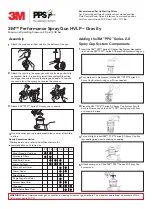
5
Always conduct a test using clean water before mixing chemicals.
Filling:
Always refer to chemical manufacturer for
proper mixture.
1. Remove the cap from the tank.
2. Make sure the filter basket is in place in the
neck of the tank. The filter basket includes
the seal and must be in place to prevent
leaks.
3. Fill the tank with water and chemical to the
desired level.
4. Reinstall the cap.
Pressurising and Spraying:
1. To begin pressurising, be sure the spray gun shut-off lever is not on. Pump handle up
and down in a smooth motion (See Figure E). Operating pressure is reached when
pumping becomes difficult, which is no more than5-7 full pumps. (Do not over-
pressurise)
2. Direct nozzle away from you and squeeze shut-off lever to begin spraying.
3. To maintain pressure while spraying, operate pump handle every 8 sec. or as needed.
4. For continuous spraying, squeeze lever and rotate lock. (See Figure F)
5. Unlock if needed and release shut-off lever to stop spraying.
Figure E Figure F
Cleaning:
1. Fill the tank with clean tap water. Replace the cap and tighten securely. (Never use hot
water for cleaning)
2. Agitate the tank to rinse the chemical from the tank walls.
3. Remove the cap and empty the contents into gravel or bare soil.
4. Refill the tank with clean tap water. Replace the cap and tighten securely.
5. Pressurise the tank as described in the Pressurising and Spraying section.
6. Direct the nozzle away from you and activate the shut-off for at least 30 seconds to
clean the pressure chamber, hose and shut-off.
7. Remove the cap and empty the contents into gravel or bare soil.
8. Repeat steps 4 - 7 until thoroughly cleaned. Remove nozzle when flushing pump system.
Clean nozzle before replacing.
Operation





























